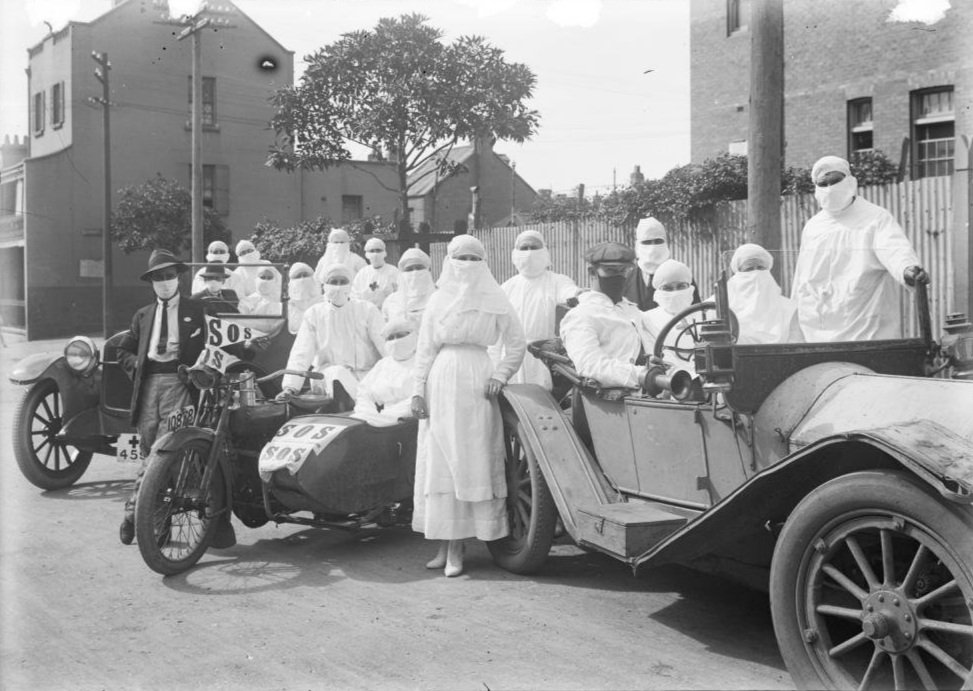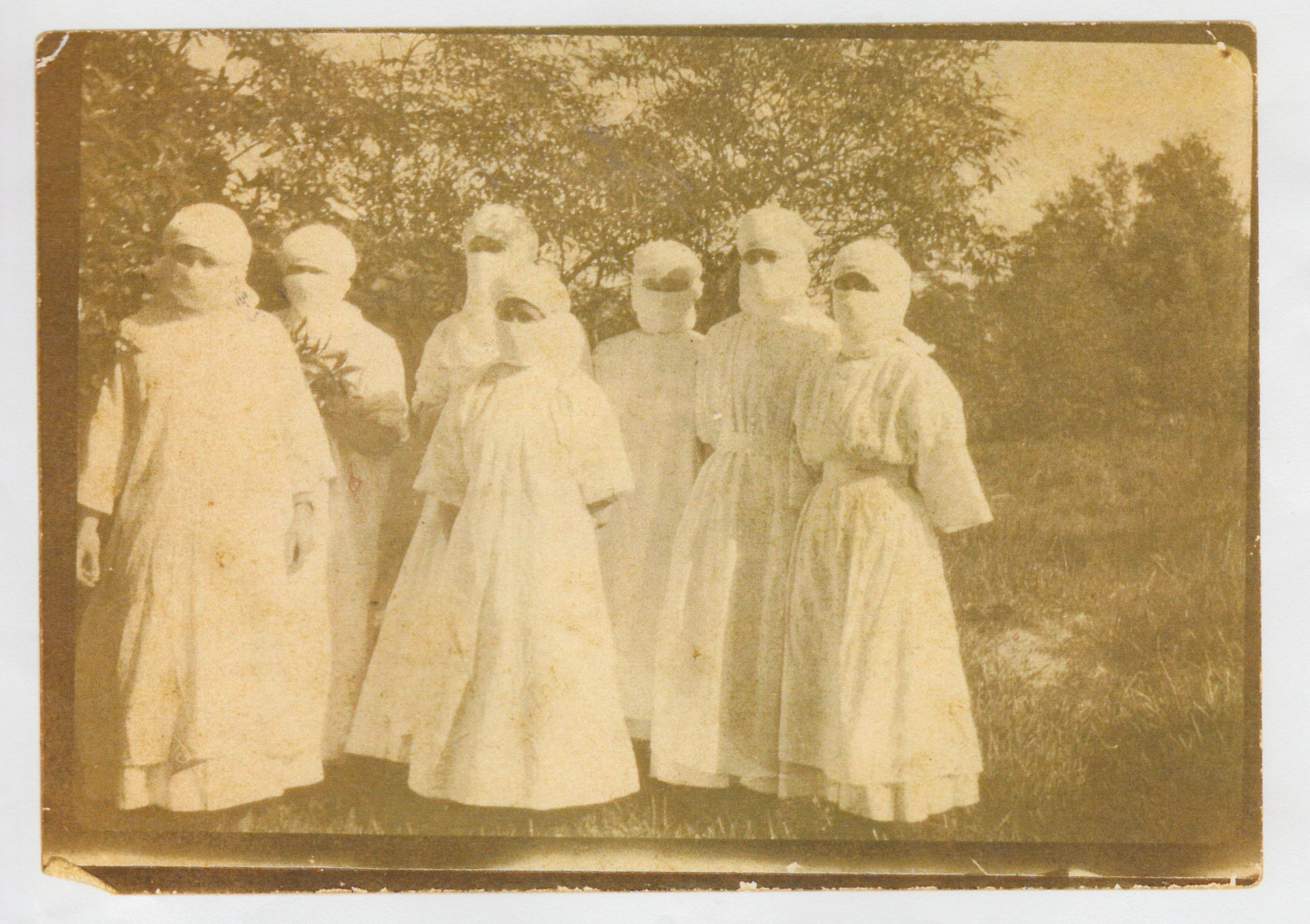Spanish flu
The current coronavirus crisis is being compared to the devastating 1919 pneumonic influenza pandemic that reached Australia in early 1919. Known as the Spanish flu it killed between 30 and 100 million people across the world. A slightly milder strain came to Australia. It still killed around 15,000 Australians, and infected around 2 million in a population of 5 million.
As with the coronavirus in 2020, governments stepped in although, in 1919, they acted earlier. Their attempts to contain the disease included inoculation, travel restrictions, quarantine, the closing of public events and institutions, the use of fumigators and the requirement to wear masks in particular circumstances. There were also altercations between states and frustrations as different regulations were introduced in different states and localities and as administrative and financial assistance was at times slow and fractured.



Images of the 1919 influenza pandemic in Australia.
To date, no photographs have been located of the response in Maitland.
The regulations – and the spread of the pandemic - were played out at state and at community level.
In Maitland
In Maitland, by early 1919 it was known that the disease was infecting people in Australia. The Maitland Mercury regularly provided updates on outbreaks elsewhere in the country.
Maitland Daily Mercury, 28 January 1919, p 4.
In preparation for the inevitable spread of the disease to the Maitland area, a local administrative committee was conceived, public meetings called, an inoculation program initiated and action taken to find a suitable site for the quarantine and care of victims.
Inoculation was organised at the Town Hall. The aim, as the Maitland Daily Mercury explained, was
… to deliver a ‘knock out’ blow by getting the whole of the population inoculated without delay.
Reminiscent of 2021 challenges in delivering vaccinations, initially some people were turned away and there was ‘crowding and crushing’ in the queues outside the vaccination centre. People were also urged to be ‘attended to by their medical advisors, all of whom have limited supplies of vaccine.’
Attention also turned to finding suitable accommodation for the quarantine and care of patients infected with the disease. In 1916 the Maitland Hospital had opened its new infectious diseases ward. It was, however, decided that the hospital isolation wards were not suitable to care for influenza patients. The wards were too close to the hospital and were already over filled with patients with other infectious diseases.
Alternative accommodation was sought. The Maitland Benevolent Home (now known as Benhome) in Regent Street, home for the long-term ill and indigent, was selected. Alternatives considered included Brough House and the Technical College (now the Maitland Regional Art Gallery) and, in response to complaints from residents of Regent St, the suggestion of ‘Rutherford or some place more remote from town’. The plan was to ‘fit up’ two wards at the Benevolent Home ‘for the reception of any cases of pneumonic influenza that might occur’ and that ‘the old people’ then in the home would be relocated to the Technical College.
The first four cases of pneumonic influenza in the district were diagnosed in late March. The Maitland Mercury named the patients and identified contacts, all of whom were ‘quarantined in their respective residences’. The plan to move the Benevolent Home residents to the Technical College was activated and the Benevolent Home made ready for its new patients. Mrs W. J. Gillies who, as Sister E.D. De Boose had worked at the Maitland Hospital, was put in charge of what became known as the (Benevolent) Isolation Hospital. She was assisted by Maitland Hospital’s Matron Skulthorpe, nurses from the hospital and volunteer local women. Individuals were also recruited to work as cook, ambulance driver, wardsman and gardener at the Isolation Hospital.
Over the next eight months, there was a growing number of cases of influenza.
The Maitland Mercury invariably named those who caught the disease, provided accounts of their places of residence, where and when they came down with the illness, who was admitted to the Isolation Hospital and how the patients in the Isolation Hospital were faring.
Assistance came from medical and nursing staff and volunteers. From early on, women from the War Chest Depot were making and distributing masks made from butter cloth, and sewing nurses’ gowns and sheets for the Isolation Hospital. Members of the East Maitland Red Cross made garments and provided other household goods. Inoculations continued to be given at Maitland Town Hall by local doctors. School children collected fresh eggs for the Isolation Hospital.
Maitland Hospital's Matron Skulthorpe organised sessions on home nursing that attracted over 50 women willing to acquire and share skills and, when influenza and other illnesses resulted in a shortage of nurses in the Maitland Hospital itself, a number of young women from the community volunteered to assist.
Public schools were temporarily closed, fumigators were installed at the West Maitland Railway Station and in the West Maitland Superior Public School, and the Maitland Hospital was closed to visitors.
A local committee was formed to assist with managing and organising the response.
Fighting and containing the disease was a community effort.
As with the coronavirus, the pneumonic flu pandemic also encouraged the offering of remedies with dubious benefits. Advertisements in the Maitland Mercury, for example, promoted ‘Stevens’ Nasal Balm’, an ‘antiseptic gargle and germicidal spray’ and a ‘eucalypt abstract’.
By mid-June the disease was affecting the running of the Maitland Hospital. Most of the nurses had become ill and the hospital was consequently short staffed. The number of patients in the Isolation Hospital reached a peak of 39 in early July, and deaths from the disease also peaked in June and July. The deaths included Mary (Mollie Carr), a young nurse caring for patients at the Isolation Hospital; Adele Hollywood, wife of James Joseph Hollywood one of the doctors working to contain the pandemic; and Frank Hinchey, a former linotype operator at the Maitland Mercury and, at the time of his death, licensee of the Royal Hotel in High St, West Maitland.
Mollie Carr’s gravestone in the East Maitland Cemetery is inscribed ‘died at the Maitland District Hospital while nursing during the influenza pandemic’.



By September 1919, the pandemic had been contained. The Maitland Benevolent Home's role as an isolation hospital ceased and was returned to its normal function. The long-term residents were relocated from the Technical Collection. Equipment acquired specifically for the isolation hospital was delivered to the Maitland Hospital. Restrictions in the community were eased.
The long-term effects – and the memory – of the pandemic remained.
References
An intimate pandemic: the community impact of influenza in 1919, Royal Australian Historical Society.
Bongiorno, Frank, ‘How Australia’s response to the Spanish flu of 1919 sounds warnings on dealing with the coronavirus’, The Conversation, 22 March 2020.
Defining moments - influenza pandemic, National Museum of Australia.
Maitland Daily Mercury, 1 January to 27 November 1919, passim.
McQueen, Humphrey, ‘The Spanish influenza pandemic in Australia 191-1919’, Australian Society for the Study of Labour History, (originally published in 1976)
Pneumonic influenza (Spanish flu) 1919, NSW State Archives and Records.
Wilton, Janis, ‘Our past: the pandemic that hit Maitland 101 years ago’, Maitland Mercury, 5 April 2020.





